Paella! This famous saffron infused rice dish is a traditional Spanish recipe that comes fully loaded with seafood or anything your heart desires! You don’t need a paella pan to cook paella, any skillet or even a large pot will do, and it’s surprisingly straightforward to make.
Terrific festive party food!
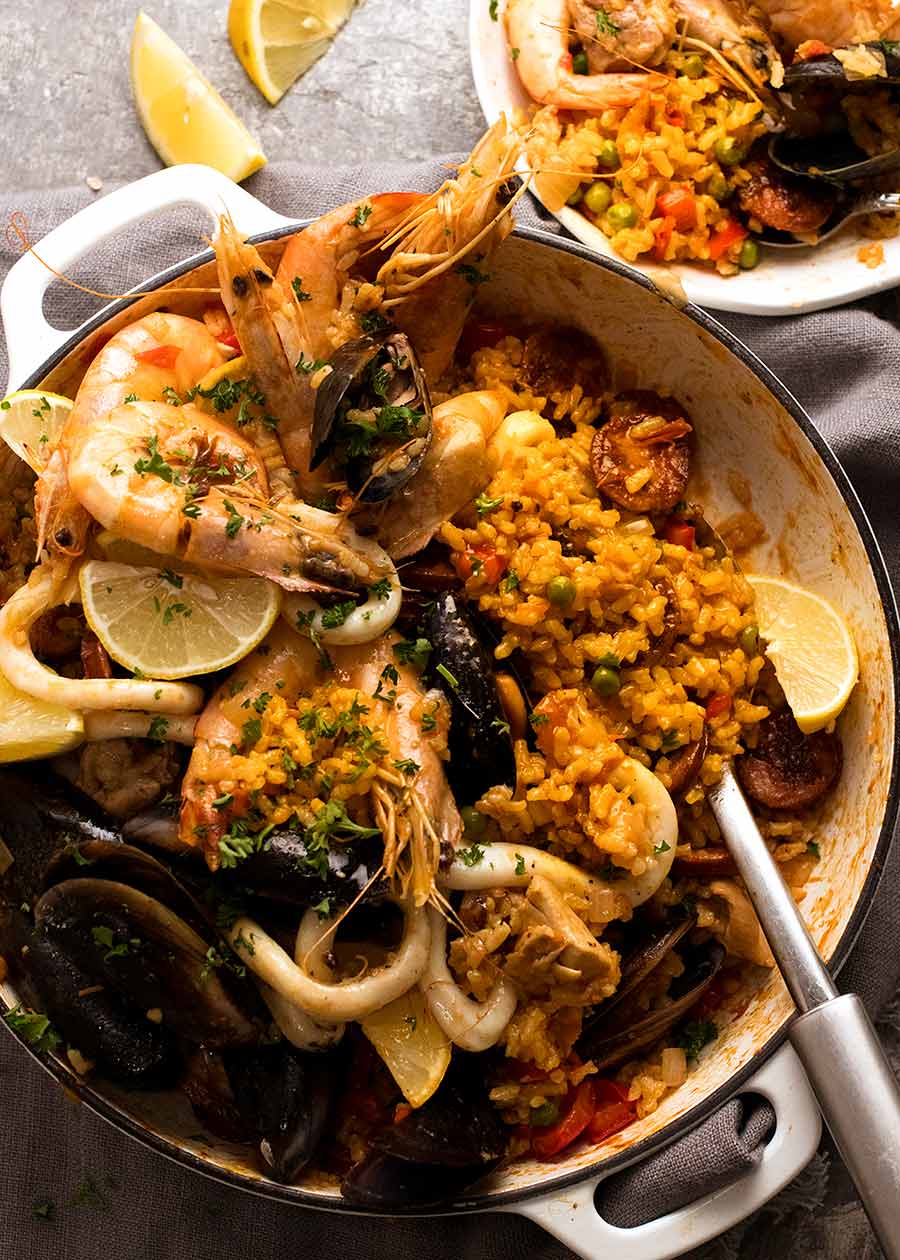
Paella recipe
If you’ve always wanted to but been too afraid to try Paella, I can assure you – there is no reason to be scared! If you approach it the right way – and I like to keep my recipes as risk free as possible – you will end up with rice that’s cooked exactly to your taste in a saffron infused, flavour loaded sauce with all your seafood cooked to perfection.
No overcooked seafood, and no mushy rice around here!
The beauty of paella is that it is in fact extremely flexible. Don’t get too hung up about getting the exact seafood I use. Don’t listen to the authors who tell you that you MUST use homemade fish broth or buy extremely expensive seafood stock.
I learnt Paella the Migeul Maestro* and Rick Stein way – as he wrote in his Mediterranean Escapes cookbook, Paella, whether it be for a quick midweek meal or a large festive gathering, is meant to be relaxed and fun, not stressful with strict rules.
So just chill out!! 😉
* Miguel Maestro is Australia’s most well known Spanish Chef.

I say this is a straightforward recipe but I AM going to spend a bit more time on explaining steps and process visuals than I usually do (short recipe video extremely helpful for first timers) because I’m guessing paella is a bit of a special occasion dish for many and I want to ensure you nail it! (And you will, I promise – if you follow my steps!)
Best rice to use for paella
The best rice to use for paella is Spanish rice labelled as:
-
Bomba Rice – or arroz bomba (“arroz” means rice in Spanish);
-
Valencia rice or Arroz de Valencia (pictured below) – the other common name for Bomba Rice; or
-
Calasparra Rice -or Arroz Calasparra.
Paella rice packets tend to be very helpful providing clues such as pictures of Paella or “perfect for paella!” splashed across it. 🙂
Where to find paella rice – here in Australia, paella rice is sold at most Woolworths and Harris Farms, some Coles, delis, Spanish or Mediterranean delis (some Italian ones too), or gourmet stores. See below for best subs using more common rice.

Paella rice is a short grain variety of rice (ie it is short in length, distinctly different from basmati which is very long). The unique quality of paella rice is that it absorbs more liquid than other types of rice without getting bloated and mushy, making it ideal for a dish like paella where you want the rice to absorb loads of flavour.
Best substitute for paella rice is risotto rice (arborio rice) which has similar characteristics ie. ability to absorb lots of liquid, except risotto goes creamy if you stir it. The next best is medium grain rice – the same rice I use for rice pudding.
I do not recommend using: brown rice, long grain white rice, black rice, wild rice or any other fancy type of rice. And in anticipation of someone asking – NO to quinoa!!! (A million Spaniards almost fainted at the thought).
What goes into Paella
I divide the stuff that goes into Paella into 2 groups:
-
The Base Ingredients – rice, aromatics (garlic, onion, saffron), stock;
-
The Add Ins – chicken, seafood, chorizo
1. The Base Ingredients

-
Paella rice – as discussed above. Buy anything labelled as Bomba, Valencia, de Valencia or Calasparra – or simply “paella rice”!
-
Saffron – a signature part of paella is the warm yellow tinge of the rice and delicate saffron flavour. Saffron is expensive, even more expensive than gold by weight! So if your budget won’t stretch to real saffron threads, use a pinch of saffron powder (it’s artificial but will provide the same colour hit and some flavour – but don’t worry, we have tons of other flavour in this paella!);
-
Stock/broth – just store bought chicken stock is fine here, we are going to get tons of seafood stock from the seafood we use. If you’re in Australia and insist on using fish or seafood stock, get the good stuff from gourmet or fish shops, do not buy supermarket cartons (they are quite nasty). US reads: I can highly recommend clam juice as an option if you want extra seafood flavour;
-
Garlic and onion – essential flavour base;
-
Tomato – fresh tomato is the traditional method but if you can’t get good juicy fresh tomato (as I couldn’t when I filmed the video), use canned instead;
-
Capsicum/bell peppers – also adds to the flavour base, I really recommend using it; and
-
Peas – optional, I like that it adds a splash of colour in an otherwise very red/yellow dish!
2. The Add Ins
And here are the proteins I put in the paella – chicken, chorizo*, calamari, prawns/shrimp, mussels. A very classic, popular combination.
* 45 million Spaniards just threw up their hands in protest at the inclusion of Chorizo, declaring it’s not traditional! But outside of Spain, it’s considered a key ingredient – and it adds a ton of flavour to the dish. 25 million Aussies would throw up their hands in protest if I left it out! So it’s in. 🙂

Forgot to include calamari in the above photo! if you don’t find rings, buy a squid tube then slice it – as pictured below.
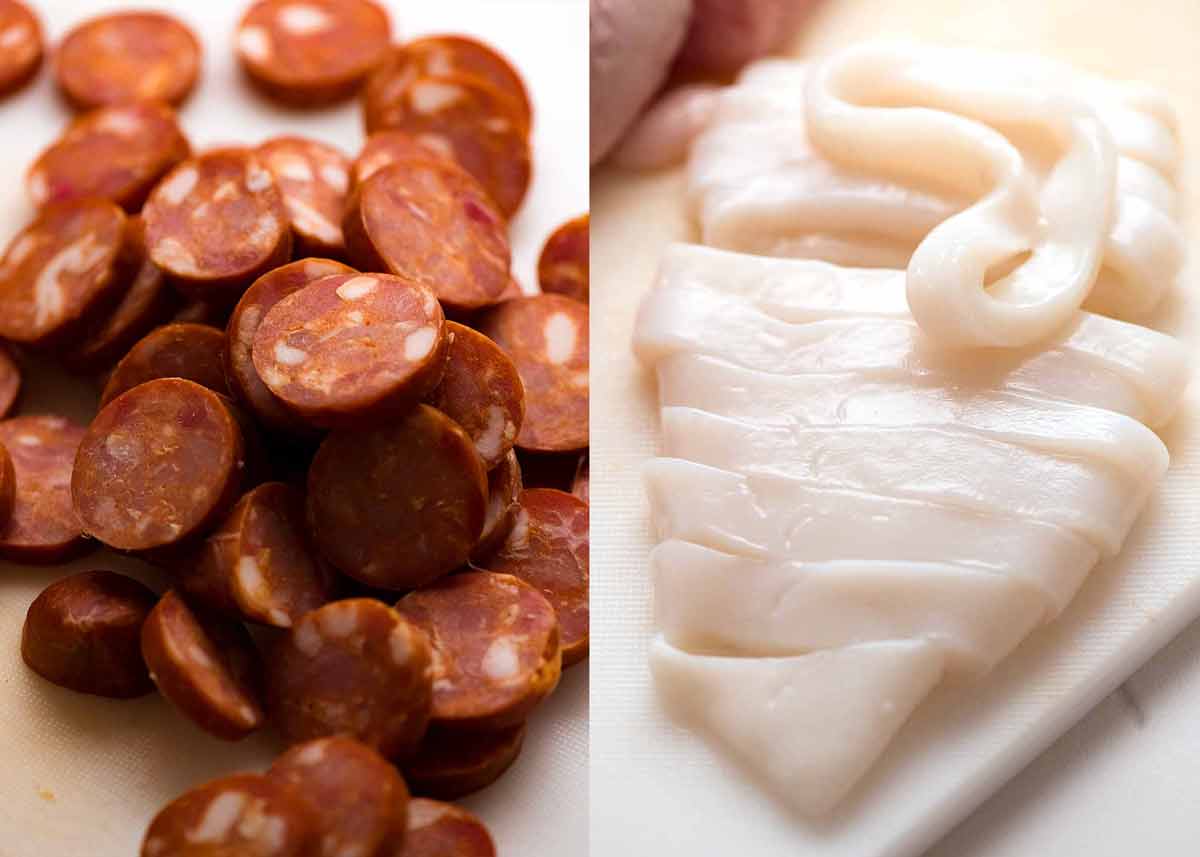
How to make paella
Here’s how to make paella in 4 simple steps:
-
sear chorizo and squid first, then remove;
-
sauté onion and garlic, brown chicken, then cook the rice in the broth with some of the chorizo;
-
partway through cooking the rice, squidge the prawns/shrimp and mussels in which will leech a STACK of juices into the rice, adding loads of flavour; and
-
pop squid back on top, then cover and rest for 5 minutes before serving!
Part 1 – sear, make flavour base, add rice and stock

This part is pretty straightforward. The only key tip here is to only cook the squid/calamari for 90 seconds – squid cooks super fast and goes rubbery quite quickly!
You don’t need a paella pan. Any large skillet will work fine – or even a wide pot. In fact, paella pans require more advanced cooking skills because the everyday paella pans tend to be quite thin which makes the rice very prone to burning unless you have a stove burner made especially for paella (they have wide rings that turn down pretty low).
Note how we return some of the cooked chorizo back in to cook with the rice. It adds great flavour into the dish as well as salt.
Part 2 – cook rice, squidge in seafood

The rice is cooked uncovered – this is a distinct cooking technique for paella compared to other iconic rice dishes of the world like Jambalaya and Biryani. Initially, we cook the rice for just 10 minutes – at this stage, it will be partially cooked though it will seem to absorb most of the liquid.
But wait! There’s more liquid to come!
We add the prawns and mussels partway through cooking the rice because they cook faster. So the idea here is that the prawns, mussels and rice all finish cooking at the same time. If the seafood was added with the rice, they would overcook. Nobody wants rubbery prawns in their paella!
The prawns and mussels (especially the mussels) leech an astonishing amount of liquid as they cook – around 3/4 of a cup. Not only does this provide the extra liquid required to finish cooking the rice, it’s essentially our very own homemade seafood stock that adds a load of incredible flavour into our paella!
Part 3 – garnish and rest!
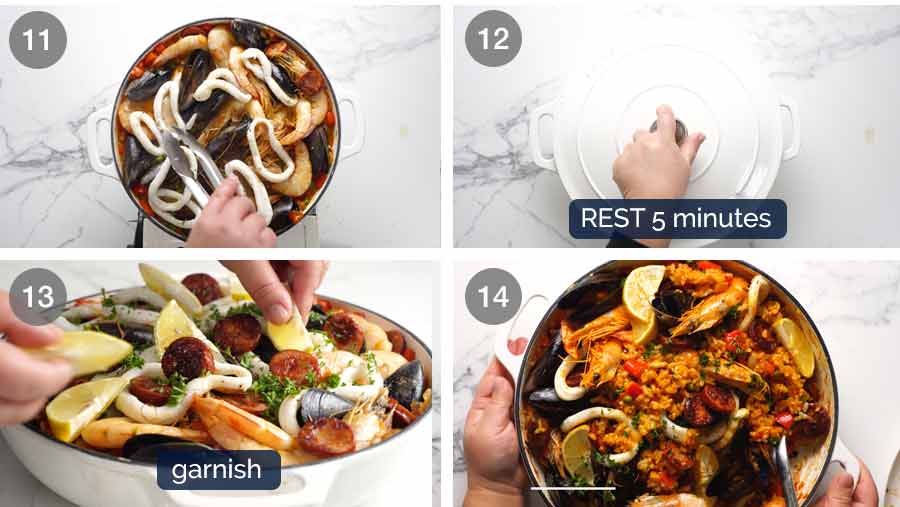
The home stretch! After 8 minutes, the prawns will be perfectly cooked and the mussels will be open so you know they’re cooked.
You will need to taste the rice to ensure it’s perfectly cooked (I know, I know, what an inconvenience! 😉). And it will still be a bit liquidy which is exactly what you want – because now we’re going to cover and rest it off the heat, during which time the excess liquid will be absorbed, leaving you with a bit pot of juicy paella rice, ready for serving!
Pop the cooked squid and reserved garnishing chorizo back on top before you cover it so the heat warms them through.
And just prior to serving, add some wedges of lemon and a sprinkle of parsley for colour!
How to serve paella
It’s entirely up to you whether you take it to the table as it is with the seafood completely covering the rice, or whether you give it a bit of a mix so the seafood gets jumbled through the rice a bit.
I tend to give it a bit of a mix to loosen the rice a bit, mix the flavour through a bit better and also disperse the seafood through. So I bring it to the table looking like this:

How much to make per person
Paella is such a great dish for a gathering because it’s easy to make loads in a giant pan or get multiple pans going at the same time! Use the scaler function on the recipe card to increase servings.
Allow for 1/3 cup / 60g of rice per person, plus around 150g / 5 oz of proteins and seafood. This is slightly on the generous side – but leftovers keep well, and nobody wants to be short!
PAELLA COOKING TIPS
Answering your burning questions about making Paella. 😉
-
What rice to use for Paella? The best rice for paella is Bomba rice, also labelled as Valencia Rice or Rice de Valencia (Valencia is the region that Paella is said to have originated from). The other common rice is called Calasparra Rice (a region in Spain where it is grown). See above in post for more information.
-
Best paella pan / skillet – Paella pans are large and shallow so the rice spreads out thinly and cooks evenly without stirring. But you don’t need a paella pan to make paella! Just use a large skillet. The key is to ensure the rice is not stacked up more than about 2 cm / 3/5″ deep (excluding the liquid & seafood added later, but including onion etc mixed throughout rice), to ensure even cooking.
-
The liquid to rice ratio for paella is usually 1 cup of rice to 3 cups of liquid which is on the softer side than ideal. I use slightly less (2.3 cups liquid per 1 cup rice) because seafood drops a LOT of liquid (especially mussels) and you can always add more water/broth at the end to soften / finish cooking rice but you cannot UNDO overcooked, bloated, mushy rice.
-
Cook in broth, not water – Fact is, the better the broth, the better the paella. The best is a homemade seafood broth. The 2nd best is a store bought chicken broth dolled up by simmering it for a while with some seafood offcuts, or make seafood paella like I have (so the flavoured seafood juices drop into the rice). The 3rd best is store bought chicken broth. Store bought fish stock doesn’t make the cut in my world – sorry. 🙂 (Unless of course, you get a gourmet homemade one.)
-
Don’t stir!! Unlike risotto, paella should not be creamy. So once you add the broth, do not stir as this will activate the starch and make it gluey. The best paellas have a golden crust on the bottom, called the soccarat, and it’s the best part of the paella. 🙂
-
Add seafood partway through cooking – Paella takes 20 to 25 minutes to cook. So squidge the seafood in partway through cooking to avoid overcooking it. Even partially submerged, it is enough heat to cook. The only exception is squid – it needs to be cooked super fast (2 minutes or less) or super long to make it tender (60 minutes). Anything in between is horrid and rubbery. For paella, we take the super fast route – cook it first, remove, add back later.

What to serve with Paella
Back in 2016, in my pre recipe video days, I shared this Paella recipe as part of a 3 course Spanish Fiesta! So here are some suggestions to make a full Spanish Feast:
-
Easy Tapas Starters – garlic mushrooms, Spanish potato tortilla, and more! (No recipe video for these, being that they’re old recipes. If you want videos, put in a request in the comments section below!)
-
This paella for the main
-
Spanish CHURROS for dessert! Astonishingly straightforward to make – 20 minutes start to finish – and they also reheat extremely well which makes them great make ahead party food!
So. Much. Food.
So, SO happy! – Nagi x
Watch how to make it
Note: recipe calls for chopped fresh tomatoes if you have find ripe juicy ones which I could not. Canned crushed tomato is the best substitute which is what I’ve used.
Hungry for more? Subscribe to my newsletter and follow along on Facebook, Pinterest and Instagram for all of the latest updates.
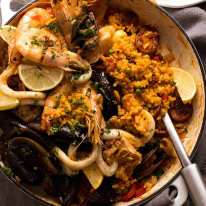
Spanish Paella
Ingredients
- 1 - 2 tbsp olive oil
- 7 oz / 200g chorizo (2 pieces) , sliced 1/2 cm / 1/5" thick (Note 1)
- 200g / 6 oz squid (calamari) , cut into 7mm / 1/4" thick rings (Note 2)
- 1 onion , diced (brown, white, yellow)
- 3 garlic cloves , minced
- 1 red capsicum / bell pepper , diced
- 1 1/2 cups paella rice ("Bomba", "Valencia" or "Calasparra" rice) (Note 3)
- 2 juicy ripe tomatoes, peeled and diced OR 3/4 cup canned crushed tomato (Note 4)
- 300g / 10 oz chicken thigh fillets , cut into 1.5" / 3.5cm pieces
- 3 1/2 cups chicken broth/stock (not low sodium) or homemade seafood broth (Note 5)
- 1 tsp saffron threads (or 1/4 tsp ground saffron, Note 6)
- 1 cup frozen peas
- 12- 16 medium / large prawns , whole (shell on) (Note 7)
- 12 large mussels , cleaned & check freshness (Note 8)
Garnish
- Fresh parsley , chopped
- 2 Lemons , cut into wedges
Instructions
- Chorizo - Heat 1 tbsp oil in a 30cm / 10" paella pan or large skillet over high heat (Note 9). Add chorizo and cook until browned on each side (~ 3 minutes). Remove with a slotted spoon and set aside.
- Squid - Add squid and cook for 45 seconds on each side, then remove and set aside.
- Garlic, onion, capsicum - Add remaining oil (if needed). Add garlic and onion, cook for 2 minutes. Add capsicum, cook for 1 minute.
- Chicken - Add chicken. Cook for 2 minutes until lightly browned but still raw inside.
- Add Rice - Add rice and mix until the grains are coated in oil.
- Cooking broth - Add in most of the chorizo (reserve 1/4 for garnish), chicken stock, fresh or crushed tomato and saffron. Stir.
- Simmer 1 - Bring it to a simmer then adjust heat so it's simmering fairly gently (not super rapidly, will burn rice). Simmer for 10 minutes - no stirring! At this stage, a bit of rice should be poking through to the surface but there should still be plenty of liquid.
- Add peas, prawns and mussels - Scatter over peas, squidge the prawns and mussels into the rice (partial submerge is fine).
- Simmer 2 - Cook for 8 minutes (turn prawns halfway if you think it's necessary) or until prawns are opaque, mussels are open, and most of the liquid has been absorbed but still a bit liquidy. Discard any mussels that do not open. Remove from stove.
- Check rice - Do a taste test to see if the rice is cooked - it should be firm but cooked. If it is too firm for your taste, no stress, just add a splash of hot water (not too much!) and keep cooking.
- Rest - Scatter over squid and reserved chorizo (residual heat will warm through), cover with lid then rest for 5 minutes (rice will absorb remainig liquid). Paella rice should now be tender but "juicy", not stodgy and thick (if it is, add splash of water to loosen it).
- Garnish - scatter with parsley and wedges of lemon. Take to table as is, then mix up rice with seafood before serving!
Recipe Notes:
- risotto rice - but add an extra 1/2 cup of water with stock
- medium grain rice - reduce water to 2 cups per 1 cup of rice (ie use 3 cups stock for 1.5 cups rice)
- long grain white rice, sushi rice - will work per medium grain rice, but finished dish mouthfeel quite different to paella (still tasty though!)
Nutrition Information:
Originally published August 2016, updated July 2020 with a new video, and lots more process steps!
Life of Dozer
Discovered a new way to exercise Dozer – using a drone! It makes me tired just watching him 😂 Also so glad that food doesn’t move…. he’s very difficult to keep up with!
And from the original publication date: At Sydney’s beautiful Bilgola Beach, drooling over this Paella on my computer screen and waiting patiently for me to finish, hoping I’ll let him hit the surf. No such luck Dozer, no dogs allowed on this beach! No swim for you this morning. And no paella either! #HardLifeForDozer



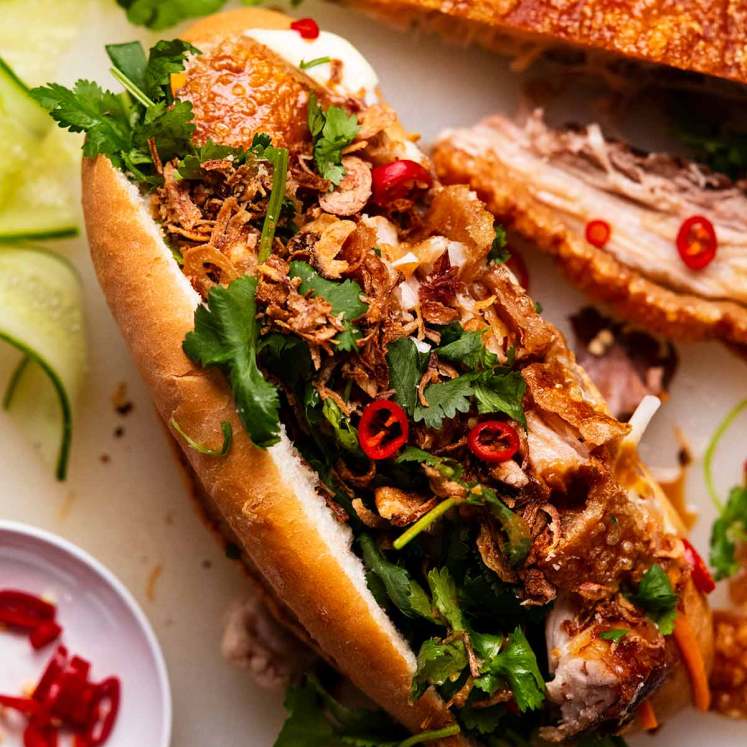

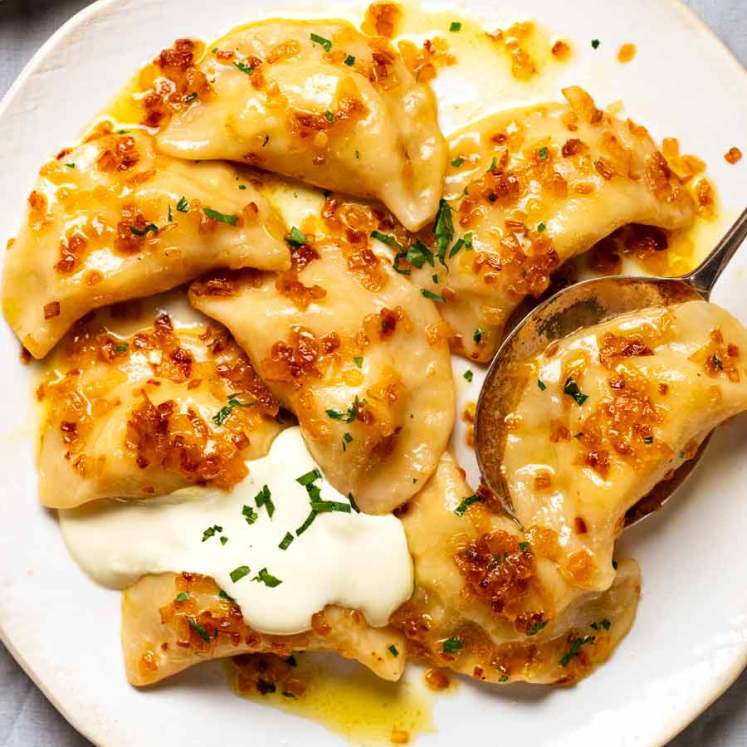
This is a great recipe! Works out just right. I had some salmon bones and mixed Campbell’s chicken stock with the bones to make a great flavour after 1st bringing to boil and refeshing.
Also added scallops last 5 minutes after searing and added addition of mushrooms and zucchini.
Thanks for those tips Graham!! Sounds delicious! N x
Seafood paella with chorizo? Ask any Spaniard, they don’t add chorizo in their paella
Thanks FD – if you scroll down through the comments or look at this post on my FB you’ll see that MANY people have told me this – I know it’s not traditional but as I say in the post, it’s my version – and it tastes great!! N x
Chorizo makes the world go round. ❤️ I’d put it on my toothpaste if I could 😂Thanks for the recipe Nagi. Can’t wait to cook it next weekend. x
I thought I’d cooked this once. But has been making this ever since, esp during special occasions. Cant fault it. Really yummy.
I spoke with my Spanish friend about the chorizo and he said he’d be more likely to lynch you for mixing the sea food with the land food. Chicken does not go in a seafood paella and vice versa.
What can I say?? I’m a rebel!! 😁🤣 N x
I live in the Canary Islands during the winter. There’s a sand storm on Gran Canaria right now so a perfect day to spend time doing some cooking. I just made your fabulous paella (minus the chorizo – I’m in Spain and would be lynched). Thank you for the great recipe it was delicious and the rice came out perfect with separate grains. It easily held it’s own against local restaurant paella.
Oh lucky you getting to live in the Canary Islands during winter!!! Jealous!! (although it’s pretty good here in Sydney summer right now!) N x
I live in the Canary Islands too and reckon that the chorizo is the best bit. Get on board, Spain! Any recipe can evolve! 😂 x
I could not find my normal paella recipe and I am glad I couldn’t as this one works really well.
I cooked for the time recommended and the only thing missing was the paella crust which I would have achieved if I cooked for about 5 more minutes.
Another winning recipe Nagi.
So delicious!! It was my first paella, and it turned out great – thanks for this recipe!
Well done Darja! N x
Made this once and it was delicious. This time I’m using a 16 inch paella pan. Will double the recipe fit.? Thanks!
Delicious paella recipe! I didn’t use chorizo so I added salt when frying the onions. I also used scallops, fried them after the calamari then added them back with the shrimp. Also skipped the chicken. So so good. Next time I might turn up the heat a little to get a crispy bottom. Will definitely be making this again!
Hi Nagi I’m just reading through this recipe as I plan on making on the weekend. Step 3 of how to make paella you’ve made a typo! Have a google what quidge means!! lol
OOOH! I’d rather not! I will sort that out thanks! N x
I couldn’t help myself – I looked! That is going away NOW! 🤣 N x
Hi Nagi – would you be willing to share the frypan details you’ve used in this Paella recipe? Nom, nom.
I made this last night. Cooking the chorizo on high heat caused the entire kitchen to be filled with smoke!
Hi Lisa…yes you should see our kitchen when testing steaks and other seared meats! Maybe turn the heat down a little bit and be sure the fan is on…hot oil does smoke! N x
I cannot believe my husband found you first😉 I’m loving your recipes! Our Australian son is marrying beautiful Rosa who is from the basque region of Spain and her dad makes a truely magnificent paella. Very traditional. They say absolutely no chorizo but I love chorizo in my paella. They put in rabbit snails etc and I think maybe the Spanish air also adds to the flavour. We are heading to Spain for their wedding in September next year but in the meantime we are going to cook your paella to get us in the mood💃🏻🕺🥘🍤
Hi,
How would the cook time and liquid/broth quantity change if I use cooked frozen seafood.
Well, I have to differ. I think the pricey seafood stock does make a difference.
Yummy! My only issue was that my paella pan was quite big(maybe around 50cm), so when I turned down the fire to simmer, only the middle part was simmering. I could see that the rice in the middle was cooked but those at the edges were not. But when I turned up the heat so that the edges can be cooked, the middle was burnt. Will try the recipe again next round but baking it instead?
Hands down the BEST paella I’ve eaten outside of Spain! Amazing ,well done Nagi 👍
So I had to steer clear of the rice and did it with quinoa…(I know you said do dare fo it but I had no choice lol)……. It was better than I expected with it not being rice!!!!!!! I made a veggie paella and I was so happy with the outcome. Although I couldn’t use the meats, I followed your steps for everything else and oh man. Paella is one of my favorites and now I can make it just as delicious at home. Thank you!
Lovely, this dish was very flavourful. Will make again and again. Won’t use any other recipe.
Lovely recipe, very flavourful. Will make again and again.